
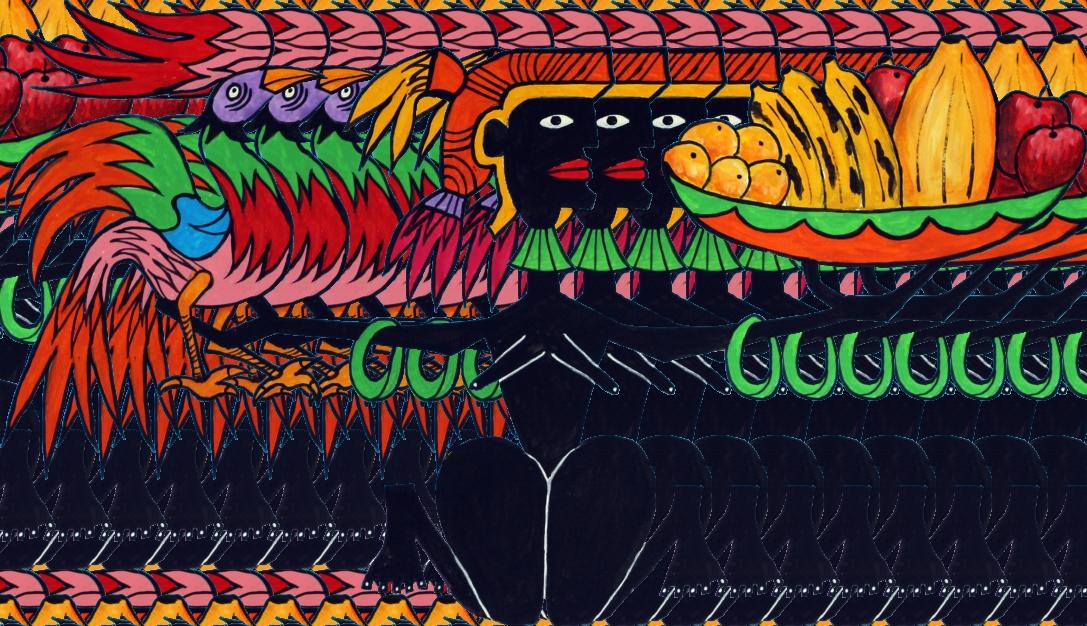
INGÊNUO E PRIMITIVO UM TRIBUTO A J. ALTAIR Naïve and primitive a tribute to J. Altair INGÊNUO E PRIMITIVO UM TRIBUTO A J. ALTAIR Naïve and primitive a tribute to J. Altair INGÊNUO E PRIMITIVO UM TRIBUT O A J . AL T AIR Naïv e and pr imitiv e a tr ib ute t o J . Altair FINANCIAMENTO C E N T N Á R D E O O D R
INGÊNUO E PRIMITIVO UM TRIBUTO A J. ALTAIR Naïve and primitive a tribute to J. Altair Patrícia Brito Curadoria Curator Produção e Execução Executive Production Porto Alegre Rio Grande do Sul Agosto • 2014 • August
Realizado por: performed by
Parceria cultural de: cultural partnership with Executado por: executed by Financiado por: financed by

Rua Cel. Feijó, 1217/103 – Higienópolis Porto Alegre/RS – CEP 90520-060 55 (51) 8574.6133 www.blackbrazilart.com blackbrazilarte@gmail.com

Marcel Knecht
Consultor internacional international consultant
E N T E N Á R O D LU C N I O R O D R G U E
Paulo Roberto Lopes de Souza
C
Sumário Summary
Apresentação Presentation
Ingênuo e primitivo um tributo a J. Altair Naïve and primitive a tribute to J. Altair Uma breve explicação da cultura iorubá Yoruba culture briefly expressed
O poder dos símbolos na cultura africana The power of symbols in African culture
Batuque: a raiz afro-gaúcha de influência iorubá Batuque: yoruba roots of the Afro gaucha religion
Coleção Ingênuo e Primitivo Naïve and Primitive Collection
Créditos Credits
05 06 07 09 13 17 23 08 11 15 20 23
63 63

APRESENTAÇÃO
A Black Brazil Art tem mantido um compromisso com a sociedade artística de mapeamento e recuperação dos valores culturais da arte afro-brasileira dentro e fora do nosso território, bem como contribuir para a valorização e a inclusão da cultura africana como instrumento de transformação. Entendemos, principalmente, que o resgate da etnia negra através das diversas manifestações artísticas e culturais valoriza não só a si como também outras etnias no que tange à construção e valorização da identidade de nosso Estado. Pensando assim, este catálogo se propõe a mostrar um pouco da cultura e da tradição da religião afro-brasileira sob a ótica de J Altair – pintor naïf e babalaô, nascido e falecido em Porto Alegre (1934-2013). Dialogar com transparência e transversalidade o significado de sua arte através de seus símbolos e dar materialidade ao sentimento popular, através do catálogo, foi o maior desafio deste trabalho. A criação do projeto, logo no início, despertou total interesse e foi um ato de valorização à nossa diversidade o seu reconhecimento internacional.
O tratamento apendicial acerca da obra de J Altair recebia citações e menções ligadas apenas à sua religiosidade. Era preciso, então, elaborar e desenvolver um olhar mais atento que estimulassem as manifestações culturais e artísticas desse artista para fazer ressurgir à identidade real o que havia além dos mitos, signos e símbolos. Consumir se, aflorar se e fortalecer se para escapar das armadilhas do pensamento único é o foco, deixando transparecer que a arte é um caminho para a democracia. A exposição Ingênuo e Primitivo: um tributo a J Altair demonstra em seu conjunto a vitalidade e o potencial da produção do artista e reúne pouco mais de 20 obras que perpassam sua vida da década de 60 à sua última fase produtiva da vida, que foi no final de 2012.
Black Brazil Art
05
PRESENTATION
Black Brazil Art is a recognized contributor in the circles of Art, and has focused its past efforts in mapping and promoting Afro-Brazilian culture and art inside Rio Grande do Sul and beyond. It is committed in promoting the values and inclusion of the Afro culture as a transformative instrument. Essentially, we hope through artistic endeavours promoting Black Brazilian cultural and artistic events, to make a positive contribution to the advancement and integration of a better Gaucha society Therefore, it is hoped that this catalogue will shed some light on the culture and traditions of African-Brazilian religion from the perspective of the late J. Altair – naïf painter and babalaô, ( Porto Alegre1934-2013).
Our challenge has been to establish a straightforward transcultural dialogue around the symbols used by this artist in his works. From its inception, this project has generated strong support and positive feedback even beyond Brazil. The treatment and attention given to the works of the late J. Altair were until now solely limited to its religious character It was necessary to develop a new approach to capture the artist's real intent, his own reality beyond the signs, symbol and myths. The catalogue and exhibit have been designed to allow everyone to choose a preferred path of interpretation while handing the tools to understand, feel or believe. The exhibition, Naïve and Primitive a tribute to J. Altair, shows a little over 20 paintings selected to illustrate the artist's creative path during the past 20 years of his life up until the end of 2012.
Black Brazil Art
06
Ingênuo e primitivo um tributo a J. Altair
É verdade que J. Altair não está mais entre os mortais, mas também nunca é demais lembrar sobre o artista, morto em fevereiro de 2013. Sua obra nunca esteve tão viva. Inimitável, ele era “babalorixá”, um terreiro da nação Ijexá, protegido e orientado por Exú-Tiriri e Obá-Daí. Era um dos maiores pintores de arte naïf ou primitiva moderna do Brasil e, talvez, um dos poucos babalaô. A trajetória do “Galo”, assim como era conhecido pela comunidade e amigos, deixa visível em muitos de seus trabalhos essa denominação.
Obsessivamente dedicado aos Orixás e aos cultos que o regem, suas pinturas retratam a mais fiel aventura a um tema na arte afro-brasileira. Passear pelas obras de J. Altair é algo mais intenso do que visualizar o simples carregar de tinta que os quadros trazem. É olhar com olhos inocentes a intensidade dos símbolos e elementos que compõem cada pintura e uma incessante e profunda busca pela linguagem da herança negra da vertente Iorubá. Para conhecer o machado duplo de Xangô, que corta dos dois lados, entre tantos outros elementos da religião é a metáfora de uma arte que duplamente pensa na tradição ocidental e incorpora genuinamente as raízes africanas da cultura brasileira. Institui, dessa forma, o caminho entre o popular e o erudito, fazendo um refinamento e visualizando nos instrumentos simbólicos, nas ferramentas das religiões africanas do candomblé, nos modos, nas vestimentas, nos adereços e na culinária uma poética visual brasileira capaz de configurar e sintetizar adequadamente todo o núcleo da arte do artista.
Mergulhando mais fundo no universo místico de J. Altair, podemos visualizar a imagística dos pontos riscados da influência da Umbanda, inexistente no candomblé da Bahia. Os signos presentes nas obras de J Altair, carregados de significados não verbais, nunca poderão ser traduzíveis por um mero acaso do olhar curioso numa visita museológica. Dessa forma, fica fácil entender porque as obras do artista se constituem num mar de semiologias, características essas que existem na cultura negra antes dessas terem inserido suficientemente seus símbolos no cenário da arte brasileira. Disso decorre a importância adicional da obra com seus códigos semiológicos emergentes de uma teogonia.
Para ir fundo na arte de J. Altair é preciso enraizar se, criar ambiências, adentrar no âmago da Terra para sentir a energia (Olodumaré – Deus Supremo) – da qual ele tanto representava – e ter um conhecimento real da frondosa e mítica “Árvore da Vida”. É preciso também ter consciência de um Brasil com negritude ferida pela escravidão, da senzala à favela, e se deixar abraçar pela pureza e a paz de Oxalá, orixá que personifica o espírito crístico Também é reconhecer sua raiz de sangue e de raça que estavam na África, pois negro era. Esta universalização de uma linguagem que independe das colonizações europeias do sul foi uma das grandezas de J. Altair e da mensagem que ele nos trouxe. O universo espiritual e brasilidade absorvidos nas variadas regiões de nosso extenso território, por raça e competência, este artista soube ligar através da pintura essa memória rica e herança ancestral.
Patrícia Brito Produtora e Curadora
07
Naïve and Primitive a Tribute to J. Altair
The late J. Altair, who passed away in February 2013 has never been more alive, through his paintings. He stands alone as one of the very few artists babalorixa, rooted in the Yoruba Ijexa tribe, protected and inspired by the divinities ExuTiriri and Oba-Dai. He is considered one of the great contemporary painters of art naïf in Brazil. These roots are in display in many of the works of “Galo” (rooster), as he was called by his friends in the art community.
His paintings exhibit this obsessive devotion to the Orixas and their cult, as practiced by Afro Brazilians. Reviewing his paintings generates a more intense experience than merely marvelling at a brilliant display of colours on a canvas: it is discovering religious symbols and elements through the eyes of innocence. It is a ceaseless search for the language and themes of the Yoruba heritage among black Brazilians. Altair designed an artistic course which, like Xango's ax, cuts both ways, integrating western artistic techniques to better express his African roots. He succeeds creating a path combining the popular and the erudite. Filtering and transforming symbols, religious elements, particularly from Candomble, postures, adornments, foods fruits into a new unique Brazilian Poetic language, is the very core of this artist's legacy A closer examination even provides an insight into the umbanda, practically absent from the Candomble of Bahia.
The symbols in Altair's works, largely impossible to transcribe into words, will always be difficult to transmit through a mere visit to a museum visitor. Thus it becomes apparent that Altair's paintings open the eye to an ancient treasure trove of signs and symbols pre existing the birth of Brazilian art, and provides keys to decode an emerging theogony.
To fully appreciate the uniqueness of Altair's artistic legacy, one must look deeper, to the core of the Earth and feel the energy (Olodumare supreme being) – which he represented so often - as well as have an authentic understanding of the mystical “Tree of Life”. Further more, one should also have an awareness of a Brazil marked by slavery, from the senzala into the favela, and allow oneself to be touched by the purity and peace of Oxala, the orixa impersonating the Christian spirit, yet embracing its African blood and roots. This universal language, immune to European colonization, is Altair's great and original contribution. It will remain significant that he was able to connect us, through his painting, to his ancestral memory, which has survived in various parts of our enormous country. This is a tribute to his talent and pride.
Patrícia Brito Curator
08
Uma breve explicação da Cultura Iorubá
Os Yorubás são encontrados por toda África ocidental, principalmente na parte sudeste da Nigéria. Compõe se de vários grupos, os Yorubás se conectam por uma língua em comum, tradições, crenças e práticas religiosas. Os Yorubás veem o mundo através da religião. Bolaji Idowu confirma isto quando diz: A religião forma a fundação e todos os princípios da vida para eles... Forma os motivos das canções, cria tópicos de reuniões, é citada nos mitos, folclores, provérbios e ditos populares, e é a base da filosofia (1963:5).
Por séculos as ideias religiosas Yorubás tem sido transmitidas oralmente. Este campo de conhecimento, conhecido como Ifa, compõe se dos ensinamentos morais e éticos dos Yorubás assim como o seu sistema principal de adivinhações. Existem 256 odu compondo o Ifa –16 maiores e 240 menores. Cada Odu contem vários subcapítulos ou ese, diz se que o numero total não pode ser contado. Dentro da sociedade Yorubá existem indivíduos o qual seu papel é se especializar no odu e transmiti-los para as futuras gerações. Estes são os sacerdotes de Ifa, os Babalawo (Pai dos segredos). Também, porém menos comum, existem mulheres são sacerdotisas de Ifa, conhecidas como iyanifa (mãe dos mistérios).
Entre os princípios unificadores da religião dos Yorubás existe o conceito de uma divindade superior, respeito pelos Orixás (Deidades/forças da natureza), a interpretação do mundo dos espíritos e do reino material, veneração aos
ancestrais, a prática de rituais, adivinhações e sacrifícios como meditação.
Os Orixás Yorubás, por vezes têm múltiplas denominações – por exemplo, Olodumare é também conhecido como Olorum (Dono do céu), e Obatala tem também o nome de Orisha'nia (Grande Orixá) Olodumare é a deidade suprema e de gênero indeterminado dos Yorubás e é considerado o ser eterno. Obatala é associada com a criação da forma física da humanidade. Junto com Orunmila, deidade da sabedoria e Ifa, estes estão entre os principais membros do panteão Yorubá.
O poder primordial feminino é representado pelas deidades Iya'Nla, Odu, e Onile Iya'Nla(Grande Mãe) é considerada a mãe de todas as coisas, incluindo os Orishas. Odu, é frequentemente equiparado com Iya'Nla, é considerada igual a Olodumare. Odu, como o nome sugere é a deidade central para adivinhações Ifa e sacerdotes e sacerdotisas Ifa. Onile (A dona da terra) é a antiga deidade da terra. Entre outras coisas ela é associada a juramentos e julgamentos.
Algumas das deidades mais populares deste lado do atlântico são Yemanjá, Oxum, Oya, Exú, Ogum e Xangô. Os Orixás são energias e personificações das forças da natureza com qual os humanos tem um relacionamento intimo e pessoal e que fazem a mediação a nosso favor através de rituais e ebós (sacrifícios e oferendas). Ebó representa o principio da reciprocidade pela qual o equilíbrio e harmonia são alcançados.
09
Um ebó é prescrito através da adivinhação e envolve não apenas a oferenda de coisas, mas de si mesmo. Além do sentimento material de dar, o ebó também acaba com comportamentos que são contra produtivos ao cumprimento do destino pessoal ou atingir uma boa conduta (iwa pele), a maior virtude dos Yorubás. Os rituais servem para manter o equilíbrio entre diversas forças, é a tecnologia que permite a manipulação de energias sutis. Axé é a energia ou força de vida que existe em toda a criação.
A respeito de questões ambientais, Raymond Ogunade estabelece que o ritual é também usado para “corrigir violações na natureza...(como) a ferramenta principal usada para se comunicar com o mundo oculto de maneira que reorganizará a estrutura do mundo físico e trará transformações materiais” (2005: 5). Assim como o ritual em si pode ser um ebo prescrito como restituição para restaurar a harmonia na vida de um individuo ou comunidade.
A esquerda está uma de minhas pinturas favoritas de João Altair. Na tradição yorubá, esta pintura pode representar uma mulher fazendo uma oferenda (ebó) a uma deidade o fato de estar de joelhos é associado a gravidez e nascimentos, Ikunle abiamo. Esta é uma poderosa postura de suplica, e somente mulheres que tiveram a experiência de dar a luz, dizem, são capazes de evocar seu poder O processo do parto e dar a luz é considerado é participar da criação com as divindades. Acredita-se que as deidades não podem recusar pedidos feitos na postura ikunle abiamo.
A tradição sagrada Yoruba foi além de suas origens, viajou para as Américas e agora é encontrada por todo o mundo. Com se sabe, o principio central da religião tradicional Yorubá é a manutenção do equilíbrio de toda a criação. Como tal, toda a criação é sagrada – realidades vistas e ocultas – seres corpóreos, ancestrais e os orixás.
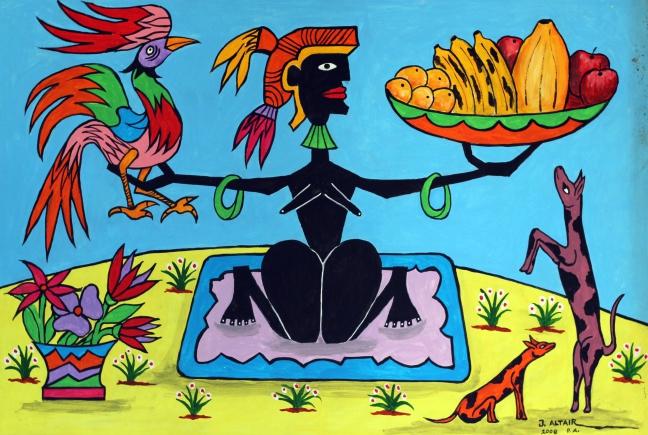
O equilíbrio não é estático. Ao invés disso é a dança de energias, constantemente se ajustando as novas realidades que se desenvolvem. A sabedoria que se ajusta e evolui é fluida e sua relevância é mantida, pois é direcionada as necessidades variáveis do individuo e da comunidade. Ifa, como uma tradição oral, evoluiu e se adaptou através do tempo para direcionar os desafios frequentes a harmonia e ao equilíbrio. As filosofias que buscam e incorporam o principio do equilíbrio são as mais necessárias no mundo atual.
Annette Williams, Ph.D Montreal, Quebec (Canadá)
10
Yoruba culture briefly expressed
The Yoruba are found throughout West Africa, but are primarily focused in southwestern Nigeria. Comprised of several groups, the Yoruba are linked by shared language, traditions, and religious beliefs and practices. Yoruba worldview is one that is steeped in religion. Bolaji Idowu confirms this when he states: Religion forms the foundation and all-governing principle of life for them. … It forms the themes of songs, makes topics for minstrelsy, finds vehicles in myth, folktales, proverbs and sayings, and is the basis of philosophy (1963: 5).
For centuries Yoruba religious ideas have been transmitted orally. This body of knowledge, known as Ifa, comprises the moral and ethical teachings of the Yoruba as well as their senior divination system. There are 256 odu in the Ifa corpus – 16 major and 240 minor Each odu contains several subchapters or ese, the total number of which is said to be innumerable. Within Yoruba society there are individuals whose role it is to master the odu and transmit them to future generations. These are the priests of Ifa, the babalawo (father of the secrets). Though less common, women are also Ifa priests known as iyanifa (mother of the mysteries).
Among the unifying principles of Yoruba religion are the concept of an overarching divinity, respect for the orisha (deities/forces of nature), the interpenetration of the world of spirit and the material realm, ancestor veneration, the practice of ritual, divination, and sacrifice as mediation.
Yoruba orisha often have multiple appellations –for instance, Olodumare is also known as Olorun (owner of the sky), and Obatala also has the name Orisha'nla (great orisha). Olodumare is the Yoruba supreme deity of indeterminate gender and is considered an eternal being. Obatala is associated with the molding of humanity's physical form. Along with Orunmila, deity of wisdom and Ifa, these are among the most senior members of the Yoruba pantheon.
Female primordial power is encompassed in the deities Iya'Nla, Odu, and Onile. Iya'Nla (great mother) is considered the mother of all things, including the orisha. Odu, often equated with Iya'Nla, is considered equal to Olodumare. As Odu's name suggests, she is central to Ifa divination and Ifa priests. Onile (owner of the earth) is the ancient earth deity Among other things she is associated with oaths and adjudication.
Some of the most popularly known deities on this side of the Atlantic are Yemoja, Oshun, Oya, Eshu, Ogun, and Shango. The orisha are energies and personifications of the forces of nature with which humans have a personal and intimate relationship and which mediate on our behalf by means of ritual and ebo (sacrifice/offering). Ebo represents the principle of reciprocity by which balance and harmony are achieved.
11
Appropriate ebo is prescribed through divination and involves not only the offering of things but also the offering of oneself. In addition to material giving, ebo also encompasses the cessation of behaviors that are counterproductive to the attainment of one's destiny or the achievement of good character (iwa pele), the highest Yoruba virtue. Ritual is the means of maintaining the balance between diverse forces; it is the technology that allows the manipulation of subtle energies. Ashe is the energy or life force with which all of creation is imbued.
In speaking of environmental issues, Raymond Ogunade states that ritual is also used to “correct perceived violations in nature…(as) the principal tool used to approach (the) unseen world in a way that will rearrange the structure of the physical world and bring about material transformation” (2005: 5). As well, ritual itself can be an ebo prescribed as restitution to restore harmony in the life of an individual or community.
To the left is one of my favorite paintings by Joao Altair. In the tradition of the Yoruba, this painting could depict a woman making an offering (ebo) to deity in the kneeling posture associated with labor and childbirth, ikunle abiamo. This is a powerful posture of supplication, and only women who have experienced labor are said be able to invoke its strength. The process of labor and childbirth is considered one of co creation with divinity. It is believed that deity cannot refuse requests made from the ikunle abiamo posture.

Yoruba sacred tradition left its home, traveled along the Middle Passage to the Americas and is now found throughout the world. As noted, a central tenet of Yoruba traditional religion is the maintaining of balance between all of creation. As such, all of creation is held sacred – seen and unseen realities – corporal beings, ancestors and orisha.
Balance is not a static equilibrium. Rather it is the dance of energies constantly adjusting to newly evolving realities. Knowledge that adjusts and evolves is fluid and its relevance maintained because it addresses the changing needs of individual and community Ifa, as an oral tradition, has evolved and adapted throughout time to address ongoing challenges to balance and harmony Philosophies that strive for and embody the principle of balance are sorely needed in today's world.
Annette Williams, Ph.D Montreal, Quebec (Canada)
12
O poder dos símbolos na cultura africana
Em todos os departamentos da vida humana, a expressão simbólica é o caminho para a liberdade criativa. O símbolo significa a abertura que apontam para possibilidades alternativas, por disposição de experimentar, na esperança de ganhar uma compreensão mais completa da realidade. São usados frequentemente quando as palavras são incapazes de expressar realidades complexas; abrem portas para um mundo maior; vão além do que é visível e tangível. Se conectam especialmente para o mundo dos mistérios, do sagrado, do profano. Um símbolo é um poderoso instrumento para alargar a nossa visão, para estimular a nossa imaginação e para aprofundar nossa compreensão. É por isso, que os africanos muitas vezes podem ver o significado simbólico das coisas e acontecimentos, porque eles estão convencidos de que a realidade é mais do que aquilo que pode ser visto e medido. Eles são capazes de ver um significado simbólico ou espiritual em eventos como doença, morte, nascimento, prosperidade e desastres, entre outros. Esse simbolismo tem uma relação de longa data com o mito, que são histórias sagradas que definem a condição humana e a relação do homem com o sagrado ou seus santos. Muitas vezes, contendo uma coleção de formas simbólicas, ações, expressões e objetos, os mitos descrevem deuses, demônios, seres humanos, animais, plantas e objetos materiais que são eles próprios portadores de significados simbólicos e intenções. Pelos símbolos delimitam-se as fronteiras de uma comunidade. Ante os símbolos, os homens se dividem: aparecem cheios de sentidos para uns, enquanto que para outros permanecem indecifráveis.
13
A fim de compreender plenamente a centralidade da arte de raiz iorubá pensei, é preciso estar ciente de sua cosmologia, que traça a origem da existência para a Divindade Suprema chamada Olodumaré, o gerador do Axé, permitindo que o seu poder sustente e transforme o universo. Ele habita em todas as coisas, animado ou inanimado, visível ou invisível. Axé é a força vital que permite que o sol brilhe, que o fogo queime, o vento sopre, a chuva caia, o rio flua e assim por diante. Auxilia Olodumaré na administração do universo e numa série de divindades chamadas de Orixá; cada um personificando seu axé em um fenômeno natural ou cultural. Por exemplo, Iemanjá personifica as águas; Obatalá, a criatividade; Orunmila, sabedoria e clarividência; Exu/Bará, mediação; Oduduwa, realeza divina; Osányìn, medicina curativa; Ogum, ferramentas, armas e guerra; Orixá Oko, a agricultura; Xangô, trovoadas e da justiça social; Oya/Iansã, tornados; Oxum, fertilidade e beleza, para citar apenas alguns. Como resultado, a religião iorubá centra-se na veneração do Orixá porque eles administram o cosmos em nome Olodumaré. É para o Orixá que os santuários são construídos e sacrifícios oferertados.
Diz a lenda que, somente os céus existiam no começo. Ao decidir criar a terra abaixo do céu, Olodumaré deu Oduduwá (o orixá da realeza divina) um saco de areia e um pássaro com a qual iriam realizar a tarefa. Oduduwá então desceu do céu por uma corrente, derramou areia sobre as águas primordiais, e colocou o pássaro sobre ele. O último a propagar areia em diferentes direções, acabou criando a terra. Isso explica por que Oduduwá é por vezes venerado como o ancestral divino dos reis iorubás ou como uma deusa da Terra (Ilê). Para os iorubás, a arte começou quando Olodumaré encomendou a criatividade da divindade de Obatalá para moldar a primeira imagem humana do barro. Ao receber uma alma (Èmi) de Olodumaré, a imagem se transformou em um feto vivo e foi então colocado dentro do útero de uma mulher grávida para se transformar em um bebê. Portanto, a alma recebe uma espécie de força (Axé) para capacitar o corpo no mundo físico. O mito não se refere apenas a arte à vida, mas também identifica a capacidade de criar e apreciar a arte como parte integrante da humanidade, transformando o que era uma vez uma selva primordial em seu atual estágio avançado de desenvolvimento.
Patrícia Brito
14
The power of symbols in african culture
Symbolic expression opens the way towards creative expression in all aspects of human endeavour. The symbol unlocks doors to new potentials, to new experiments and hopes of attaining a higher sphere of understanding Symbols often are being used whenever words become unable to transmit complex realities. They lead to a greater dimension, transcend the visible and tangible, and connect particularly well to the world of sacred mysteries beyond the profane. A symbol is a powerful instrument to enlarge our perspective, stimulate our imagination and deepen our understanding That explains why Africans, show a special disposition to interpret symbols, for they are convinced that there is more to reality than what can just be seen. They can detect a symbolic or spiritual explanation in various events, such as diseases, death, birth, prosperity or disasters. This symbolism has an ancient connection to myth, or sacred accounts which define human condition and the relation of human beings with the sacred and its holy beings. Often taking various shapes, actions, expressions and objects, these myths describe divinities, demons, humans, animals, plants and other material objects, themselves carrying symbols and meaning. It Is through its symbols that a community defines its own frontiers. Faced with symbols, men tend to divide themselves: full of significance for some and undecipherable for others.
15
To fully appreciate a Yoruba rooted work of art I strongly feel that one must become familiarized with this culture's cosmology, which relates the beginning of our universe to its supreme divinity Olodumare, generator of Axe, and allowing its power to sustain and transform the world. He resides in everything, alive or inanimate, visible or invisible. Axe is the vital energy which makes the sun shine, causes fire to burn, wind to blow, rain to fall, river to flow and so on. Olodumare is assisted by a number of divinities known as Orixas to administer the universe. Each one injects its own Axe into a phenomenon natural or cultural. For instance, Iemanja impersonates water, Obatala creativity, Orunmila knowledge and clairvoyance, Exu Bara mediation, Oduduwa, divine majesty; Osanyin curative medicine; Ogun, artifacts, weapons and war; Orixa Oko agriculture; Xango, thunder and social justice; Oya Iansa tornadoes; Oxum, fertility and beauty, to mention only a few As a result, Yoruba religion is centred around the worship of Orixas, because they manage the universe on behalf of Olodumare. It is to honour them that sanctuaries are erected and sacrifices offered.
Legend has it that in the beginning only was sky. When Oludumare decided to create the Earth underneath, He handed a bag of sand and a bird to Oduduwa (orixa of divine majesty) to implement the task. Oduduwa went down using a rope, spread the sand upon the primeval waters and released the bird, who started to spread the sand in all directions, thus shaping up the land. This is why Oduduwa was once worshipped as divine ancestor to Yoruba monarchy, or as goddess of Earth(Ile). In Yoruba lore, Art began when Olodumare ordered Obatala to sculpt the first human figure from clay. The sculpture morphed into a living fetus when Olodumare gave it a soul (Emi), which he then placed into the uterus of a pregnant woman to become a baby. Therefore the soul receives a type of energy(Axe) to enable the body in the physical world. The myth does not only refer to art and life but also stresses the ability to create and appreciate art as an integral part of mankind, thus transforming what once was a primeval forest into our present evolved world.
Patrícia Brito
16
Batuque: A raiz afro-gaúcha de influência Iorubá
Batuque é uma Religião Afro-brasileira de culto aos Orixás encontrada principalmente no estado do Rio Grande do Sul, Brasil, de onde se estendeu para os países vizinhos tais como Uruguai e Argentina. O Batuque é fruto de religiões dos povos da Costa da Guiné e da Nigéria, com as nações Jêje, Ijexá, Oyó, Cabinda e Nagô.
A estruturação do Batuque no estado do Rio Grande do Sul deu-se no inicio do século XIX, entre os anos de 1833 e 1859 (Correa, 1988 a:69). Tudo indica que os primeiros terreiros foram fundados na região de Rio Grande e Pelotas. Têm-se notícias, em jornais desta região, matérias sobre cultos de origem africana datadas de abril de 1878, (jornal do comércio, Pelotas). Já em Porto Alegre, as notícias relativas ao Batuque, datam da segunda metade do século XIX, quando ocorreu a migração de escravos e ex escravos da região de pelotas e Rio Grande para Capital.
Os rituais do Batuque seguem fundamentos, principalmente das raízes da nação Ijexá, proveniente da Nigéria, e dá lastro as outras nações como o Jêje do Daomé, hoje Benim, Cabinda (enclave Angolano) e Oyó, também, da região da Nigéria. O Batuque surgiu como diversas religiões afro-brasileiras praticadas no Brasil e tem as suas raízes na África, tendo sido criado e adaptado pelos negros no tempo da escravidão. Um dos principais fundadores do Batuque foi o Príncipe Custódio de Xapanã. O nome batuque era dado pelos brancos, sendo que os negros o chamavam de Pará.
As entidades cultuadas são as mesmas em quase todos terreiros, os assentamentos tem rituais e rezas muito parecidos, as diferenças entre as nações é basicamente em respeito às tradições próprias de cada raiz ancestral, como no preparo de alimentos e oferendas sagradas. O Ijexá é atualmente a nação predominante, encontra-se associado aos rituais de todas nações. No batuque, se cultuam vários Orixás, oriundos de várias partes da África, e suas forças estão em parte dentro dos terreiros, onde permanecem seus assentamentos e na maior parte na natureza: rios, lagos, matas, mar, pedreiras, cachoeiras etc., onde também invocamos as vibrações de nossos Orixás.
Todo ser humano nasce sob a influência de um Orixá, e em sua vida terá as vibrações e a proteção deste que está naturalmente vinculado e rege seu destino, com características individuais. O Orixá exige sua dedicação, onde este poderá ser um simples colaborador nos cultos, ou até mesmo se tornar um Babalorixá ou Iyalorixá.
São consideradas Religiões Afro brasileiras, todas as religiões que tiveram origem nas religiões africanas, que foram trazidas para o Brasil pelos escravos: Batuque, Candomblé, Catimbó, Culto aos Egungun, Culto de Ifá, Jurema sagrada, Quibanda, Macumba, Tambor de-Mina, Umbanda, Xangô do Nordeste, Xambá. As Religiões Afro-brasileiras são relacionadas com a Religião Iorubá e outras religiões africanas, e diferentes das Religiões Afro caribenhas como a Santeria e o Vodu.
17
O culto, no Batuque, é feito exclusivamente aos Orixás, sendo o Bará o primeiro a ser homenageado antes de qualquer outro, e encontra-se seu assentamento em todos os terreiros, no Candomblé o chamam de Exú. Entre os Orixás não há hierarquia, um não é mais importante do que o outro, eles simplesmente se completam cada um com determinadas funções dentro do culto. Os principais Orixás cultuados são: Bará, Ogum, Oiá-Iansã, Xangô, Ibeji (que tem seu ritual ligado ao culto de Xangô e Oxum), Odé, Otim, Oba, Ossain, Xapanã, Oxum, Iemanjá, Oxalá e Orunmilá (ligado ao culto de Oxalá). E há também divindades que nem todas nações cultuam como: Exú Elegbara, Gama (ligada ao culto de Xapanã), Zína, Zambirá e Xanguín (qualidade rara de Bará) que só os mais antigos tem conhecimentos suficientes para fazer seus rituais.
No Rio Grande do Sul a área de conservação das religiões africanas vai de Viamão à fronteira do Uruguai, com os dois grandes centros de Pelotas e de Porto Alegre. No batuque, os templos terreiros são quase que em sua totalidade vinculados as casas de moradia. É destinado um cômodo, geralmente na parte da frente da construção onde são colocados os assentamentos dos Orixás. Neste local são feitos todos os fundamentos de matanças e trabalhos determinados, oferendas para os Orixás, e o local é considerado sagrado, pessoas vestidas de preto, mulheres em dias de menstruação não entram. Junto a esta parte da casa, chamada de quarto de Santo ou Peji, há o salão onde são realizadas as festas para os Orixás.
O estado do Rio Grande do Sul foi o maior responsável pela exportação dos rituais africanos para outros países da América do Sul, entre eles Uruguai e Argentina, que também procuram seguir a maneira de cultuar os Orixás, e a construção dos templos seguem exemplos dos seus sacerdotes. Todos os Orixás são montados com ferramentas, Okutás (pedras) etc. e permanecem dentro da mesma casa, com exceção do Bará Lodê e do Ogum Avagãn, que tem seus assentamentos numa casa separada, ficando à frente do templo onde recebem suas oferendas e sacrifícios. A casa dos Eguns também tem lugar definido, é
uma construção separada da casa principal, na parte dos fundos do terreiro, onde são feitos diversos rituais.
Em caso de falecimento do Babalorixá ou Iyalorixá, dono do terreiro, fica a critério da família o destino do templo, geralmente não tendo um familiar que possa suceder o morto o templo é fechado. Na maioria dos casos na morte de um sacerdote, todas as obrigações são despachadas num ritual especifico chamado de Erissum (Axexê), por este motivo é muito difícil encontrar Ilês (casas) com mais de 60 anos, são muito poucos os sacerdotes que destinam seus axés à um sucessor, para dar prosseguimento à raiz.
Os rituais são próprios e originais e embora tenha alguma semelhança com o "Xangô de Pernambuco", é muito diferente do Candomblé da Bahia. Os rituais de Jêje tem suas rezas próprias (fon), e ainda se vê este belo ritual em dois grandes terreiros na cidade de Porto Alegre, as danças são executadas de par, um de frente para o outro. Há também muitas casas que seguem os fundamentos da nação Oyó que se aproxima muito do ijexá, já que, estas duas provem de regiões próximas na Nigéria. A principal característica do ritual do Batuque é o fato do iniciado não poder saber em hipótese alguma que foi possuído pelo seu Orixa, sob pena de ficar louco.
18
Cada Babalorixá ou Iyalorixá tem autonomia na prática de seus rituais, não existem nomenclaturas de cargos como tem no Candomblé, exercem plenos poderes em seus ilês. Os filhos de santo se revezam nos cumprimentos das obrigações. No mínimo uma vez por ano são feitos homenagens com toques para os Orixás, mas as festas grandes são de quatro em quatro anos. Chamamos de festa grande a obrigação que tem ebó, ou seja quando há sacrifícios de animais de quatro patas aos Orixás, cabritos, cabras, carneiros, porcos, ovelhas, acompanhados de aves como galos, galinhas e pombos.
Esta obrigação serve para homenagear o Orixá "dono da casa" e dos filhos que ainda não possuem seu próprio templo. A data é geralmente a mesma que aquele sacerdote teve assentado seu Orixá, a data de sua feitura. As festas têm um ciclo ritual longo, que antigamente duravam 32 dias de obrigações, hoje diante das dificuldades duram no máximo 16. O começo de tudo são as limpezas de corpo e da casa, para descarregar totalmente o ambiente e as pessoas, de toda e qualquer negatividade; em seguida são preparados as oferendas e sacrifícios ao Bará. A partir deste momento, os iniciados já ficam confinados ao templo, esquecendo então o cotidiano e passam a viver para os Orixás por inteiro até o final dos rituais. No dia do serão (dia da obrigação de matança), todos Orixás recebem sacrifícios de animais. Os cabritos e aves são preparados com diversos temperos e servidos a todos que participarem dos rituais, tudo é aproveitado, inclusive o couro dos animais, que sevem para fazer os tambores usados nos dias de toques.
No dia da festa o salão é enfeitado com as cores dos Orixás homenageados. A abertura se dá com a chamada (invocação aos Orixás), feita pelo sacerdote em frente ao peji (quarto de santo), usando a sineta (adjá), saudando todos Orixás. Ao som dos tambores, as pessoas formam uma roda de dança em louvor aos Orixás, a cada um com coreografias especiais de acordo com suas características. No final das cerimônias são distribuídos os mercados, (bandejas contendo todo tipo de culinária dos Orixás como: acarajé, axoxó (milho cozido e fatias de coco), farofa de aves, carnes de cabritos (cozidas ou assadas), frutas, fatias de bolos etc.), alguns consomem ali mesmo, outros levam para comer em casa.
Durante a semana são feitos outros rituais de fundamentos para os Orixás, inclusive a matança de peixe, que para os batuqueiros significa fartura e prosperidade, os peixes oferecidos são da qualidade Jundiá e Pintado; estes são trazidos vivos do cais do porto ou do mercado público, onde o comércio de artigos religiosos é intenso. No sábado seguinte é feito o encerramento das obrigações, com mesa de Ibejes e toque, novamente em homenagem aos Orixás, neste dia são distribuídos mercados com iguarias e o peixe frito, significando a divisão da fartura e prosperidade com os participantes das homenagens aos Orixás. Após o encerramento, o sacerdote leva os filhos que estavam de obrigações ao rio, à igreja, ao mercado público e à casa de alguns sacerdotes, que fazem parte da família religiosa, para baterem cabeça em sinal de respeito e agradecimento; este passeio faz parte do cumprimento dos rituais. Após o passeio todos estão liberados para seguirem normalmente o cotidiano de suas vidas.
19
No Batuque também temos a parte dos rituais destinados ao culto dos Eguns. Este é um ritual cheio de magia e segredos onde poucos sacerdotes têm o completo domínio. A casa dos Eguns (espíritos dos mortos) fica numa construção separada da casa principal, nos fundos do terreno, onde são feitos diversas obrigações em determinadas datas e quando morre alguém ligado ao terreiro; este local é denominado Balê.
Aos Eguns também são oferecidos sacrifícios de animais, e comidas diversas que fazem parte somente deste ritual, não podendo ser usados em outras ocasiões. Os Eguns, assim como os Orixás, tem suas rezas (cânticos) próprias, feitos na linguagem yorubá. Cada nação tem rituais diferentes para este tipo de obrigação.
O babalorixá ou Iyalorixá tem a responsabilidade de formar novos sacerdotes, que darão continuidade aos rituais. Para isto é preciso preparar novos filhos de santo, que durante um certo período de tempo aprenderão todos os rituais para preservação dos cultos. O sacerdote chefe deve passar aos futuros Pais ou Mães de Santo, todos os segredos referente aos rituais tais como: uso das folhas folhas sagradas), execução de trabalhos e oferendas, interpretação do jogo de búzios, e até mesmo como preparar um novo sacerdote. Geralmente o futuro sacerdote já nasce no meio religioso, onde conviverá acompanhando todos os diversos rituais que darão suporte a seus afazeres dentro do culto, e terá pleno conhecimento de todos os tipos de situações que enfrentará em seu futuro templo.
O tempo de aprendizado é longo, não se forma um verdadeiro sacerdote de Orixás com menos de sete anos de feitura, e os ensinamentos são passados de acordo com a evolução da capacidade de aprendizado que o noviço tem, já que os ensinamentos são feitos oralmente, não há livros para ensinar os rituais, a melhor maneira de aprender tudo é conviver desde cedo dentro dos terreiros. A partir do momento que um noviço se torna um sacerdote de Orixá, terá as mesmas responsabilidades daquele que lhe passou os ensinamentos.
20
Patrícia Brito Maike de Ogum – Tenda Africana Nossa Senhora Aparecida
Batuque: Yoruba roots of the afro-gaucha religion
Batuque is a an afro brazilian religion dedicated to the worship of Orixas, mostly present in the State of Rio Grande do Sul, Brazil. From there it spread to neighbouring Uruguay and Argentina. Batuque stems from the religions of people of Guinea and Nigeria, particularly the nations tribes Jeje, Ijexa, Oyo, Cabinda and Nago.
Batuque began to implant itself in Rio Grande do Sul at the beginning of the XIXth century, between 1833 and 1859 (Correa, 1988 a:69). Apparently the first terreiros (houses of worship) were founded around the towns of Rio Grande and Pelotas. There are already mentions of Batuque activities in news items of Porto Alegre in the second part of the nineteenth century, at the time of slave and ex slave migration from Rio Grande and Pelotas to the Capital.
Batuque rituals follow the teachings and is rooted in the practices of the Ijexa tribe of Nigeria, and are linked as well to other peoples, such as the Jeje of Daome, today Republic of Benin, the Cabinda of Angola, and the Oyo, also of Nigeria. Batuque appeared in Brazil owing its African roots to the transplantation of slaves who brought and adapted its practices. One of its principal founders was Prince Custódio de Xapanã. Batuque was a name given by whites, while practitioners called it Pará.
The same divinities are worshipped in practically all terreiros, and the objects of cult follow identical
rituals and prayers, the differences residing mainly in some practices linked to the distinct ancestral origins, such as the type of foods and consecrated offerings. The dominant influence is from the Ijexa, and their rituals are found associated to those of all other tribes. Batuque faithful worship various Orixas, originating from different regions of Africa, and whose energy resides within their own terreiros and sacred objects, and also in all of Nature: rivers, lakes, forests, quarries, waterfalls, etc, where they can also be invoked and felt.
Every human being is born under the influence of a particular Orixa, and one's life will be placed under its specific energy and protection guiding one's destiny. The Orixa will expect every human's devotion, whether a simple worshipper and even more so once becoming Babalorixa or Iyalorixa.
All religions brought over by slaves from Africa to Brazil are considered to be Afro brazilian religions: Batuque, Candomble, Catimbo, Cults of Egungun, Cult of Ifa, sacred Jurema, Quibanda, Macumba, Tambor de Mina, Umbanda, Xango do Nordeste, Xamba. These religions are linked mainly to Yoruba and other African cultures, and different from the Caribbean religions of Santeria and Voodoo.
21
The Batuqueiros worship exclusively the Orixas, Bara being the first to be honoured before any other, and whose objects are found in all terreiros. In the Candomble he is known as Exu. There is no particular hierarchy among Orixas, and they simply complement one another based on their part within the rituals. The main Orixas being worshipped are Bara, Ogum, Oia-Iansa, Xango, Ibeji (whose rituals are linked to the cult of Xango and Oxum), Ode, Otim, Oba, Ossain, Xapana, Oxum, Iemanja, Oxala and Orunmila (linked to Oxala). There are also divinities not universally worshipped, for example: Exu Elebara, Gama (linked to Xapana), Zina, Zambira and Xanguin (rare attribute of Bara). Being so for the latter, because only older people remember enough to perform their rituals.
In Rio Grande do Sul, Afro brazilian religions are practiced between Viamão and all the way to the border with Uruguay, with two main centres in Pelotas and Porto Alegre. The temples of worship (terreiros) are pratically always within a residence. Generally a room is reserved to this end, in the front of the house, with all the objects pertaining to the Orixas. All rituals, sacrifices and offerings are made there. The room is considered holy ground, people dressed in black and women having their period not allowed in. Next to this part of the house known as Quarto de Santo (holy room) or Peji, is the hall where all Orixas festivals are celebrated.
The state of Rio Grande do Sul was the main starting point for the spread of African rituals throughout South American countries, principally Uruguay and Argentina. There, followers also worship the Orixas and build houses of cult following the state's established model. All Orixas are set up with their own attributes and Okutas (stones), etc. They share the same house, except for Bara Lode and Ogum Avagan, whose objects are kept in a separate place, in front of the terreiro where they receive their offerings and sacrifices. The house of the Eguns also have their own
place, apart from the main house, generally at the back of the property.
At the death of the Babalorixa or Iyalorixa, landlord of the terreiro, it is up to the family to decide whether to maintain the temple in operation. In case nobody being able to continue, it is closed. A special ceremony, known as Erissum (Axexê) is conducted to end the sacred character of the terreiro. For this reason, it is rare to encounter Iles (terreiros) of more than 60 years. Very few priests transmit their axes to a successor to pursue the tradition.
Batuque rituals are specific and original, with some similarities with the Xango of Pernambuco, and quite different from Candomble of Bahia. The rituals of Jeje have their own rules (fon) and its beautiful dances and rituals are still executed nowadays in two large terreiros in Porto Alegre. There are also many terreiros following the rules of the Oyo tribe, quite close to those of Ijexa, both originating in Nigeria The defining characteristic of Batuque is that the initiate can't ever know which Orixa possessed him, under penalty of losing one's mind.
22
Each Babalorixa or Iyalorixa has full autonomy in establishing his or her practices, and unlike the established hierarchies of Candomble, have full dominion over their Iles. The priests alternate in fulfilling the rites. Every year, special days are dedicated to celebrate various Orixas, but the main events take place every 4 years. They are known as Major Celebration (festa grande) and feature Ebo, that is to say the sacrifices of animals to the Orixas, be it goats, rams, pigs, lambs, along with roosters hens and pigeons.
This celebration is conducted to honour the Orixa as well as the owner of the house, and his sons who do not yet have their own temple. The date coincides generally with the anniversary of the priest's ordination. The celebrations last a long time, in the past more than 32 days and nowadays reduced to cycles of 16 days for practical reasons. They begin with the cleaning of the body and the house, in order to relieve people and places of all negativity; then offerings to Bara are prepared. Starting then, all initiates are confined within the temple, removed from their normal routine, devoting themselves entirely to serve the Orixas until the end of the rituals. On the Day known as the long day (when sacrifices are offered ) all Orixas receive sacrifices of animals. Goats and poultry are cooked with various seasonings and shared with all in attendance. Everything is used, including the skin of the animals used to make drums used on the days of festivals.
The great hall is decorated with the colours of the Orixas being honoured. The festival begins with the Call (an invocation to the Orixas), made by the priest in front of the peji (quarto de santo) using a little bell (adja) calling all Orixas. All people form a dancing circle, in praise of the Orixas following the rhythm of the drums, with a special choreography to reflect each Orixa's specific attributes. At the end of the ceremonies, the mercados are served (trays featuring all sorts of Orixa related food specialties like: acaraje, axoxo (corn and slices of coconut), meats boiled, fried or grilled, fruits, slices of cake, etc), some take it home and others eat on the spot.
During the week, other rituals take place, including the offering of fish, which for batuqueiros symbolize abundance and prosperity. Generally sweet water fish like the Jundia and the Pintado; these are brought alive from the harbour or the public markets, where the commerce of religious artifacts is also in full swing On the ensuing saturday, the ceremonies come to a close, with a table of Ibejes (sweets to honour this Orixa protecting children) and the beating of drums ,again in honour of the Orixas. On that day, fried fish and other specialties are distributed, symbolizing the sharing of abundance and prosperity among all attendants. At the end of the ceremonies, the priest brings his sons who served with him to the river, the church, the public markets and the house of other priests belonging to the religious family, invoking the presence of the Orixas in sign of respect and gratitude; this marks the end of the rituals. Afterwards all participants are free to return to their regular lives.
23
Batuque also has a special set of rituals devoted to the Eguns. These are full of magic and secrecy, that very few priests master completely The house of the Eguns (spirits of the departed) is set apart from the main residence, at the back of the property, where various rituals take place at set dates and when someone related to the terreiro; passes away this place is known as Bale.
The Eguns also receive sacrifices of animals and various foods reserved exclusively to their rituals. They have their own prayers (canticos) recited in Yoruba. Each nation-tribe has different rituals for this type of occasion.
Each Babalorixa or Iyalorixa has the obligation to form new priests who will continue the tradition. To this end they prepare new filhos de santo who for a period will learn all the rituals required to ensure the proper performance of the religious services. The head priest must pass on to the future Fathers and Mothers all the secrets related to the rituals: how to use the sacred leaves, how to implement rites, works and offerings, how to interprete the oracle of the buzios (coquillages), and even how to form a future priest. Generally a future priest comes from a family with a religious background and has the opportunity to grow up getting to observe and participate in all situations and events related to his future responsibilities.
It is generally expected that it takes at least 7 years to form a new priest to serve the Orixas. The teachings are adjusted to the capacity of each student to absorb the required knowledge. All teachings are transmitted orally, for there is no book where this knowledge has been consigned. From the moment a novice becomes a priest he becomes invested with the same responsibilities as the priest from whom he learnt.
Patrícia Brito Maike de Ogum – Tenda Africana Nossa Senhora Aparecida
24
COLEÇÃO INGÊNUO E PRIMITIVO
Naïve and Primitive Collection
25
Exú-Tiriri
Óleo s/ Tela, 1967 42 x 62cm Coleção Particular
Obá-Daí
Óleo s/ Tela, 1967 42 x 62cm Coleção Particular

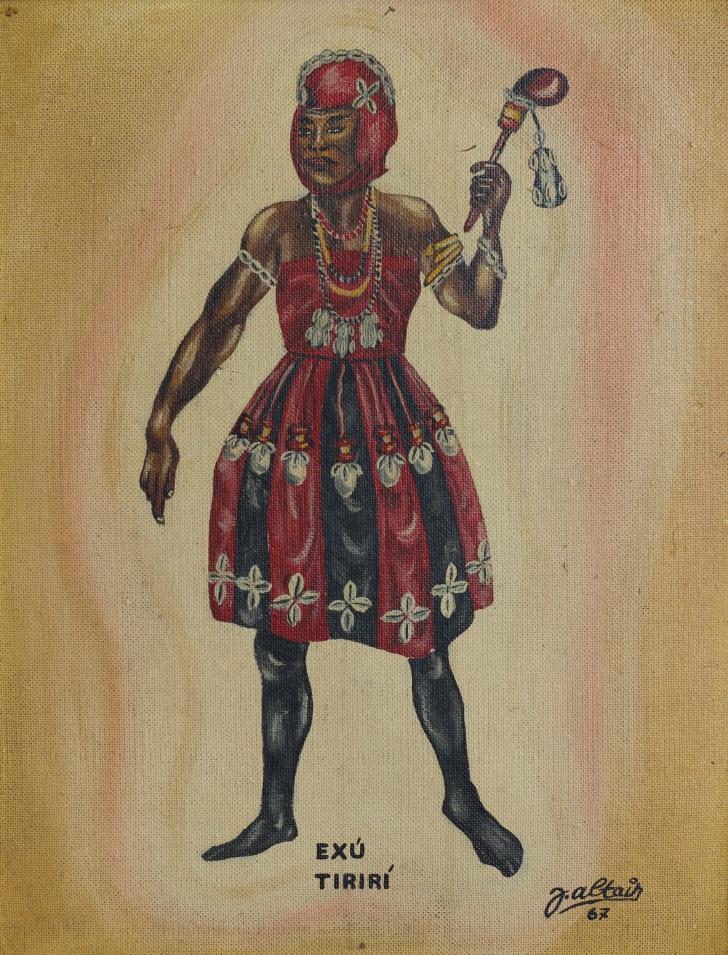
26
Coleção Ingênuo e Primitivo Naïve and Primitive Collection
Coleção Ingênuo e Primitivo Naïve and Primitive Collection

Ponte de Pedra

Óleo s/ Tela, 1970 24,2 x 35,2cm
Acervo Pinacoteca Aldo Locatelli
Prefeitura de Porto Alegre (Leopoldo Plentz)
Santo Guerreiro
Óleo s/ Tela, 1971 100,6 x 100,2cm
Acervo Pinacoteca Aldo Locatelli
Prefeitura de Porto Alegre (Leopoldo Plentz)
27
Coleção Ingênuo e Primitivo Naïve and Primitive Collection
A Ressurreição
Óleo s/ Eucatex, 1977 49 x 67cm Acervo Mian


Procissão
Óleo s/ Eucatex, 1990 72 x 98cm Acervo Mian
28
Coleção Ingênuo e Primitivo Naïve and Primitive Collection


A Sagrada Família
Acrílica s/ Eucatex, 1989 137,6 x 122,3cm
Acervo Mian
São Sebastião
Acrílica s/ Eucatex, 1989 136,7 x 121,7cm
Acervo Mian
29
Coleção Ingênuo e Primitivo Naïve and Primitive Collection
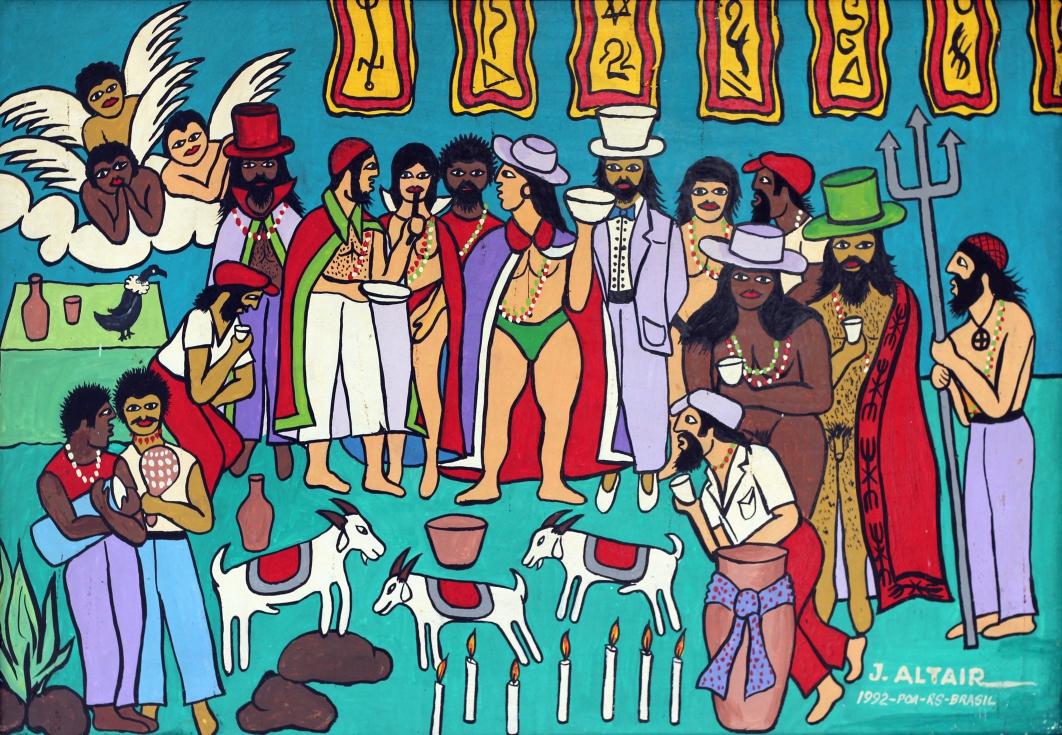

Gira de Exú
Acrílica s/ Eucatex, 1990 50 x 35cm Acervo Mian
Sagrado e Profano
Acrílica s/ Eucatex, 1992 53 x 38,5cm
30
Coleção Ingênuo e Primitivo Naïve and Primitive Collection
Rito Iniciático
Acrílica s/ Eucatex, 1992 53 x 38,5cm
Coleção Particular
Ritual de Fertilidade

Acrílica s/ Eucatex, 1992 53 x 38,5cm

31
Coleção Ingênuo e Primitivo Naïve and
Primitive Collection
A dança de Obá


Acrílica s/ Eucatex, 1996 48,5 x 68,5cm
Rito
Acrílica s/ Eucatex, 1996 48,5 x 68,5cm
32
Coleção Ingênuo e Primitivo Naïve and Primitive Collection
A posição de joelhos O culto a fertilidade
Óleo s/ Tela, 1995
100 x 200cm Coleção Particular
O poder mitológico da religião
Óleo s/ Tela, 1996 100 x 200cm Coleção Particular


33
Coleção Ingênuo e Primitivo Naïve and Primitive Collection


Égún
(espírito dos ancestrais)
Acrílica s/ Tela, 2007 56x44cm
Ipadê (a reunião)
Óleo s/ Tela, 2002 52x62cm Coleção Particular
34
Coleção Ingênuo e Primitivo Naïve and Primitive Collection


Ibó (lugar de adoração)
Acrílica s/ Eucatex, 2008 53,5 x 36,5cm Coleção Particular
Iyalaxé (mãe do axé)
Acrílica s/ Tela, 2008 65x45cm
35
Coleção Ingênuo e Primitivo Naïve and
Primitive Collection
Bô (adorar)
Acrílica s/ Tela, 2008 44x52cm

Dabòbò (proteção)
Acrílica s/ Tela, 2008 61x42cm

36


37
Coleção Ingênuo e Primitivo Naïve and Primitive Collection
Acrílica s/ Tela, 2008 60x45,5cm Ebo (oferendas e sacrifífios) Acrílica s/ Eucatex, 2008 65 x 52cm Aláàfin (rei de Oyó)
Coleção Ingênuo e Primitivo Naïve
and Primitive Collection
Dédá (boa saúde)
Acrílica s/ Eucatex, 2008 53,5 x 36,5cm
Labalábá (borboleta)
Acrílica s/ Eucatex, 2008 65 x 46,5cm


38
Coleção Ingênuo e Primitivo Naïve and Primitive Collection

Kunle (ajoelhar no chão)
Acrílica s/ Eucatex, 2008 47,5 x 68cm
Agbára (poder)
Acrílica s/ Eucatex, 2008 44 x 60cm
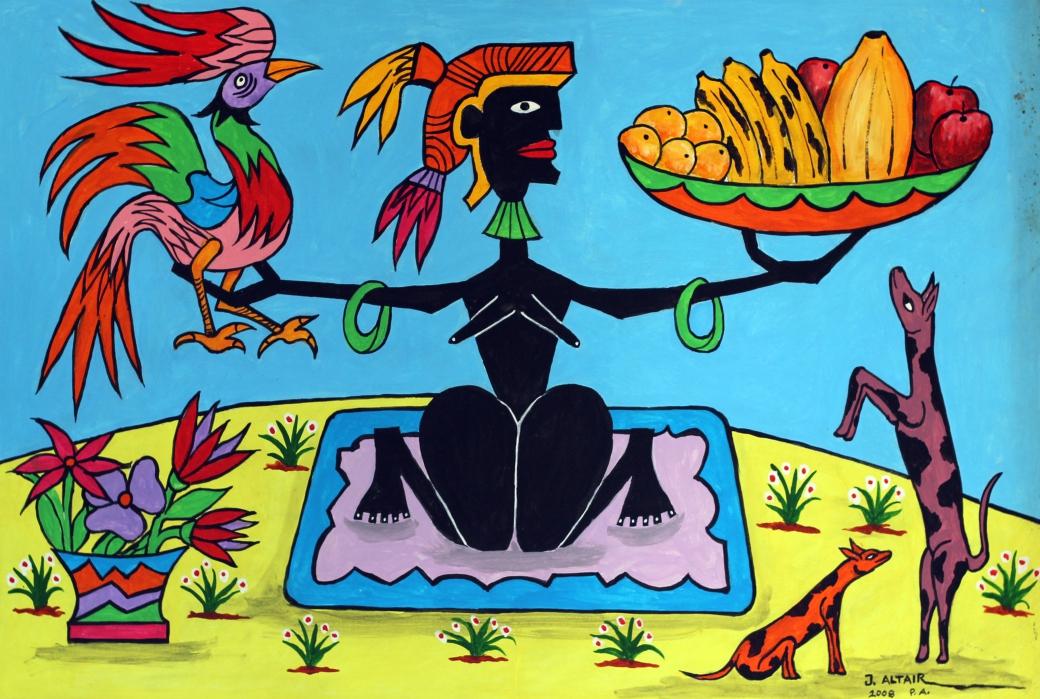
39
Coleção Ingênuo e Primitivo Naïve and Primitive Collection

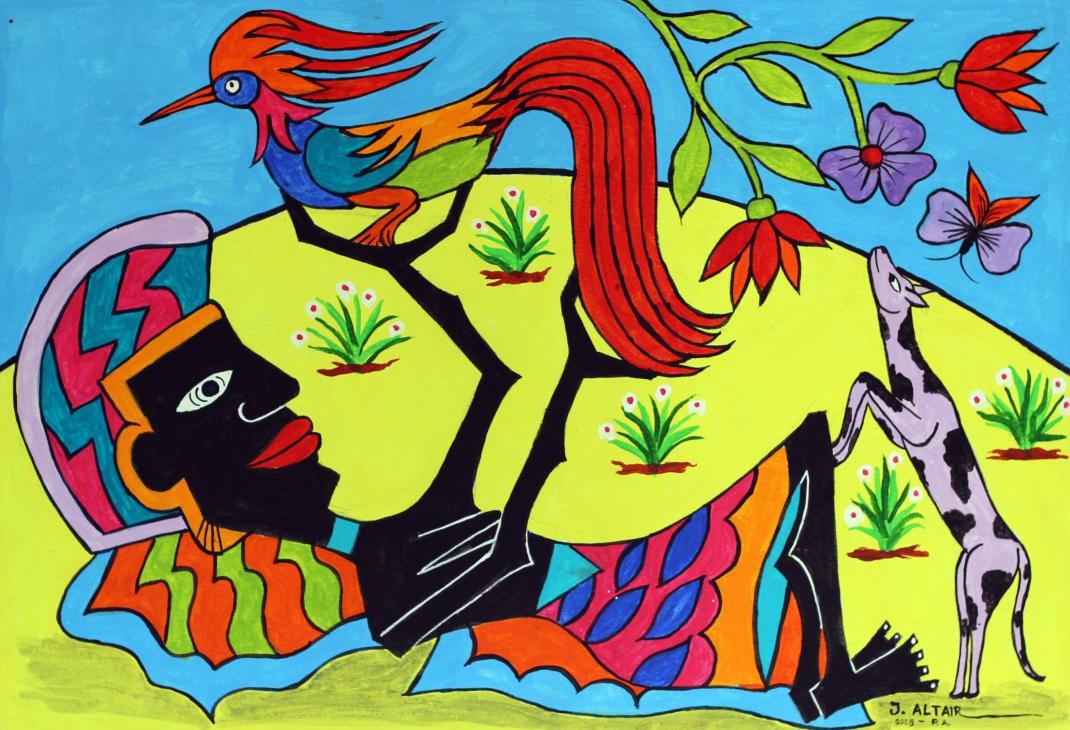
Àkùko (galo)
Acrílica s/ Eucatex, 2008 63 x 44,5cm
Si Ori (abrir a cabeça)
Acrílica s/ Eucatex, 2008 49 x 59,5cm
40
Coleção Ingênuo e Primitivo Naïve and Primitive Collection

Abánigbèro (conselheiro)

Acrílica s/ Tela, 2008 59 x 49cm
Ààyè (vida)
Acrílica s/ Eucatex, 2008 49 x 59cm
41
Coleção Ingênuo e Primitivo Naïve and Primitive Collection

Abaya (rainha mãe)
Acrílica s/ Eucatex, 2009 58 x 40cm
Adé (coroa)
Acrílica s/ Eucatex, 2009 59 x 40cm

42
Coleção Ingênuo e Primitivo Naïve and Primitive Collection

Adie (galinha)
Acrílica s/ Eucatex, 2009 49,5 x 69cm
Abòrisa (aquele que cultua os orixás)
Acrílica s/ Tela, 2009 69 x 49cm

43
Coleção Ingênuo e Primitivo Naïve and Primitive Collection
Ibá (colar cheio de objetos)
Acrílica s/ Tela, 2009 60 x 45cm
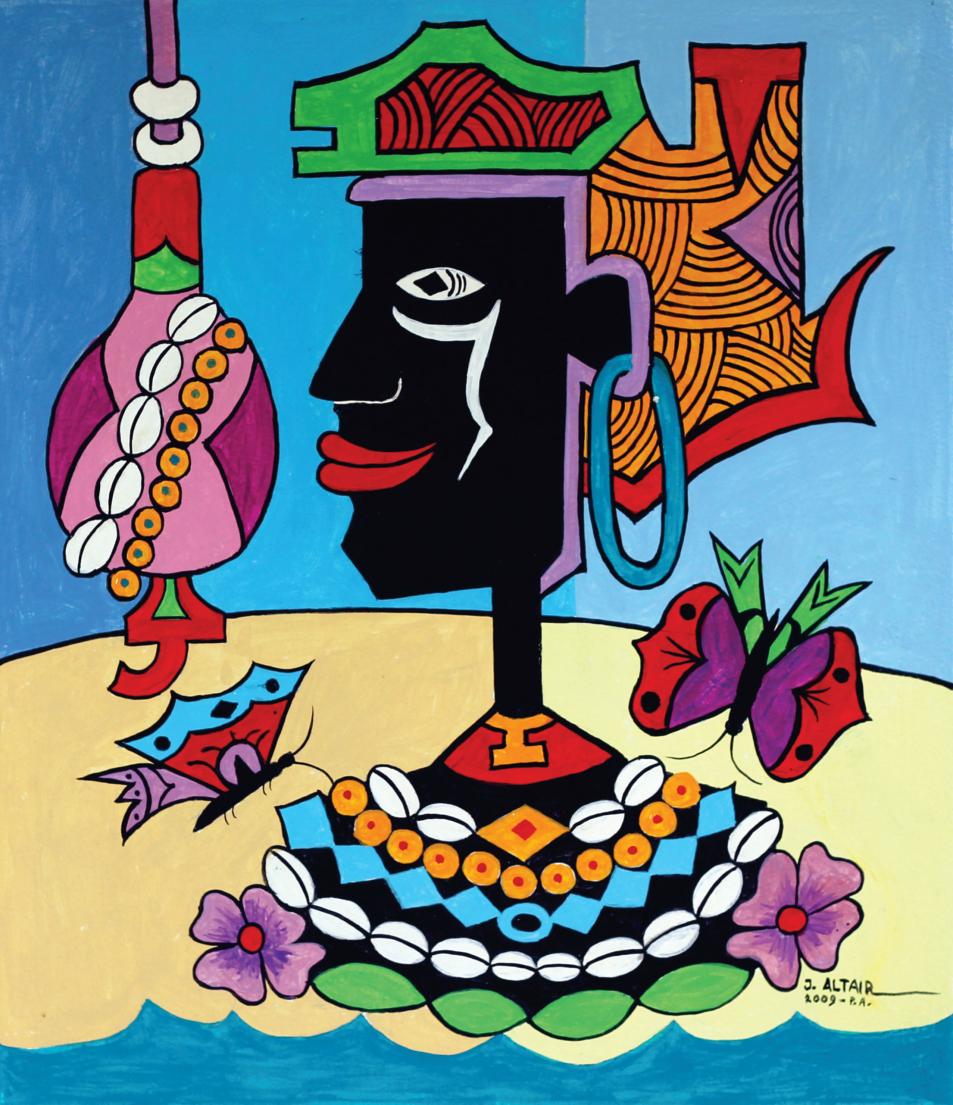
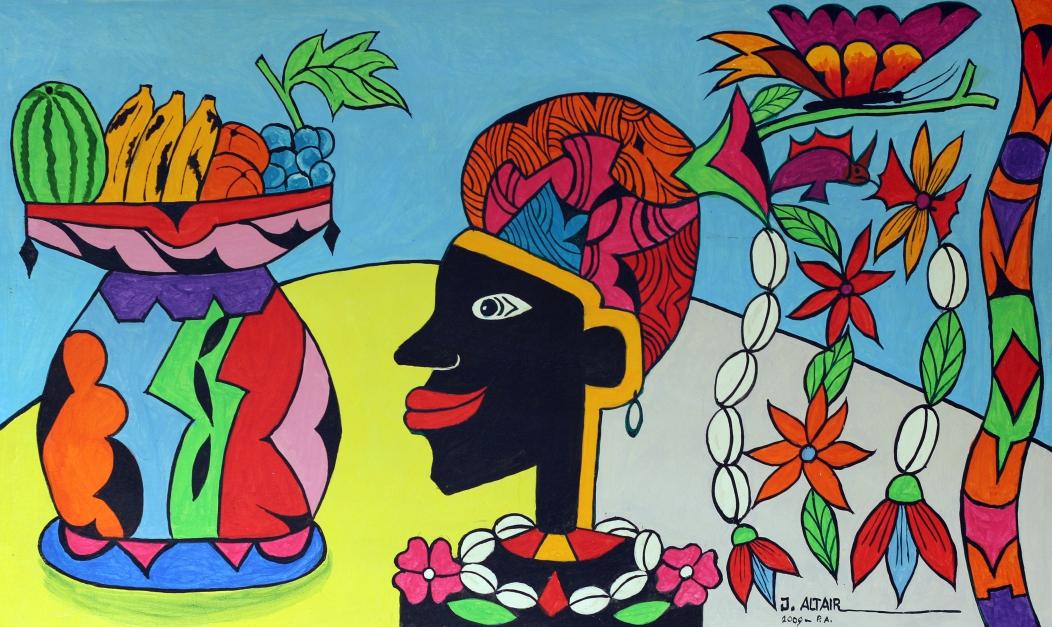
Eya (tribo)
Acrílica s/ Eucatex, 2009 57 x 50cm
44
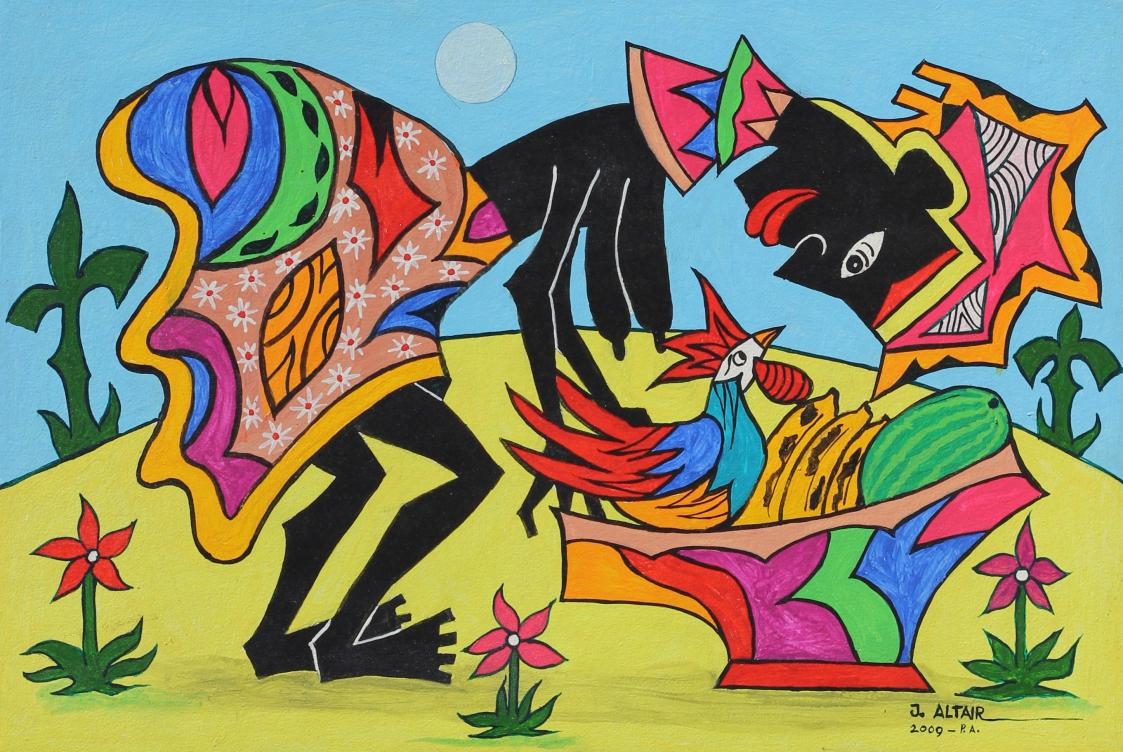

Coleção Ingênuo e Primitivo Naïve and Primitive Collection 45 Acrílica s/ Eucatex, 2009 57 x 50cm Dáda (beleza) Acrílica s/ Tela, 2009 64 x 46cm Obinrin (mulher)
Coleção Ingênuo e Primitivo Naïve and Primitive Collection
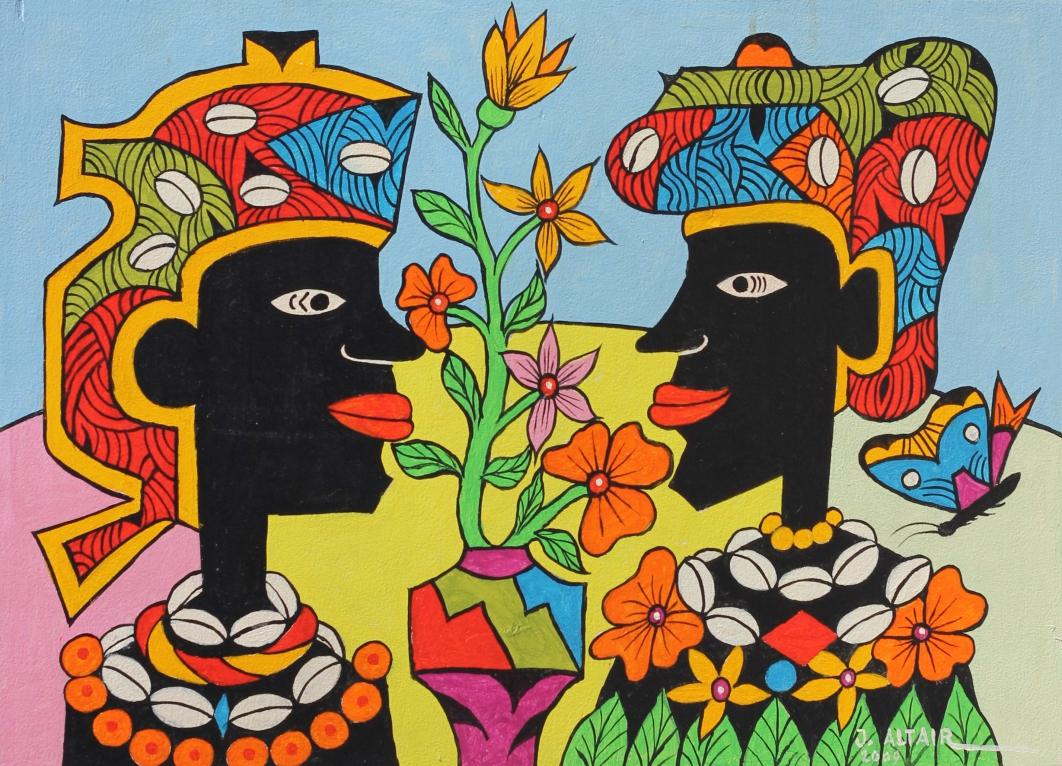

Yibi (grandeza)
Acrílica s/ Tela, 2009 69 x 49cm
Sarapebé (mensageiro)
Acrílica s/ Tela, 2010 63 x 43cm
46
Coleção Ingênuo e Primitivo Naïve and Primitive Collection

Rèrè (coisas boas)
Acrílica s/ Tela, 2010 59,5 x 40cm
Sùrú (paciência)
Acrílica s/ Tela, 2010 63 x 43cm

47
Coleção Ingênuo e Primitivo Naïve and Primitive Collection

Sinsin (descansar)
Acrílica s/ Tela, 2010 43 x 63cm
Peji (altar de santo)
Acrílica s/ Tela, 2010 43 x 63cm

48
Coleção Ingênuo e Primitivo Naïve and Primitive Collection
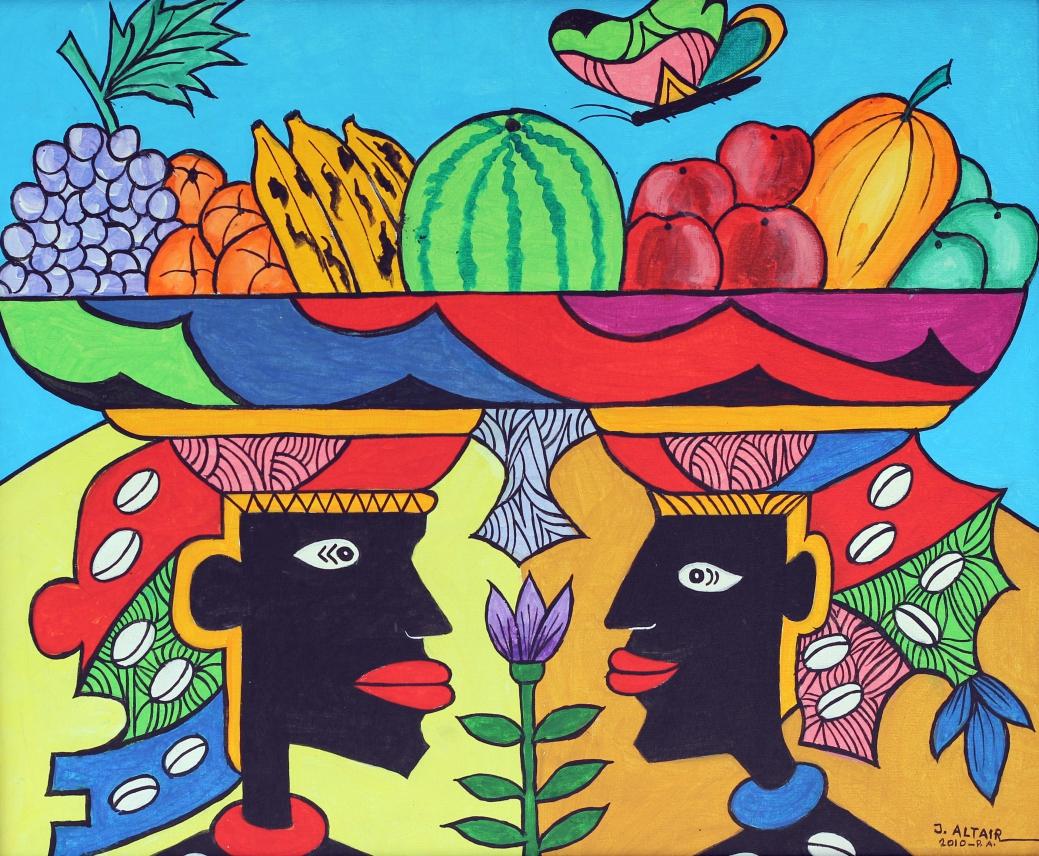
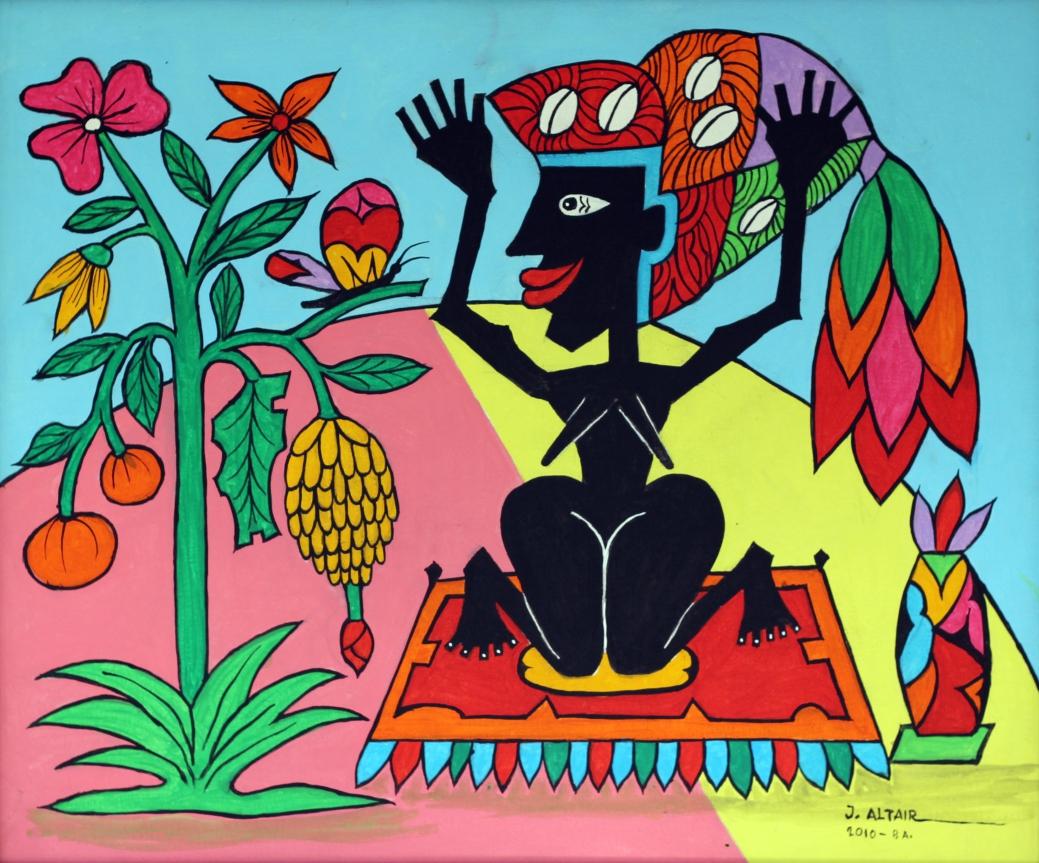
Ajeum (comida)
Acrílica s/ Tela, 2010 63 x 43cm
Coleção Particular
Àse (poder e força vital)
Acrílica s/ Tela, 2010 63 x 53cm
49


50
Coleção Ingênuo e Primitivo Naïve and Primitive Collection
Odé (caçador) Acrílica s/ Tela, 2010 59 x 49cm Acrílica s/ Eucatex, 2010 59,5 x 49,5cm Àjapá (tartaruga)


Naïve
Collection 51 Acrílica s/ Eucatex, 2010 59,5 x 49,5cm Ajá (cão) Acrílica s/ Tela, 2010 49 x 59cm Adufe (pequeno tambor)
Coleção Ingênuo e Primitivo
and Primitive
Coleção
Ingênuo
e
Primitivo
Naïve and Primitive Collection
Omi Ayé (as águas da terra)
Acrílica s/ Tela, 2010 43,5 x 64cm Coleção Particular
Odù (destino)
Acrílica s/ Tela, 2010 63 x 43cm Coleção Particular

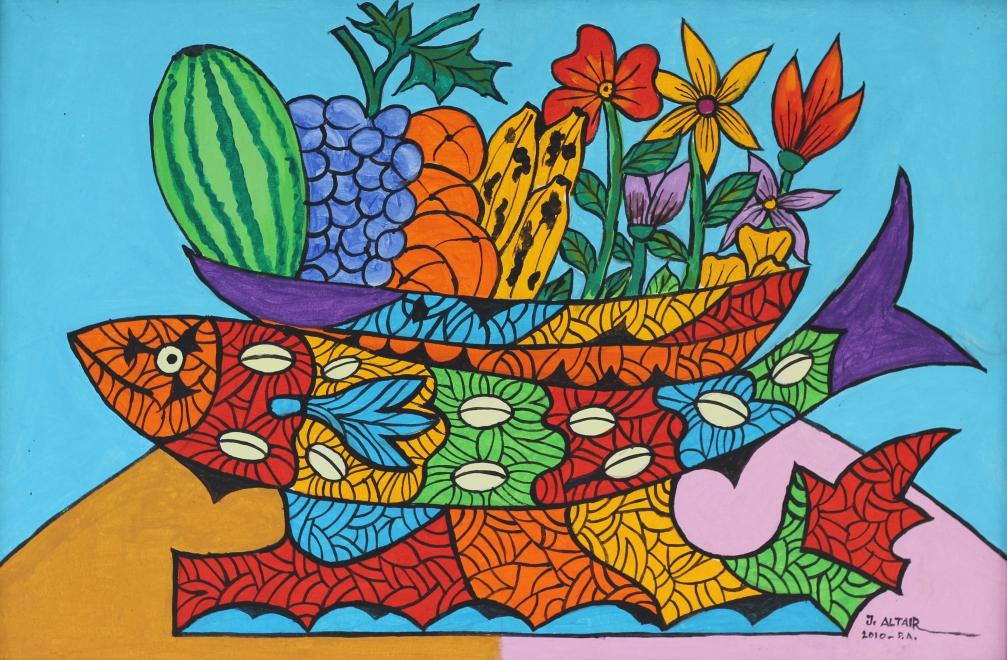
52
Coleção Ingênuo e Primitivo Naïve and Primitive Collection
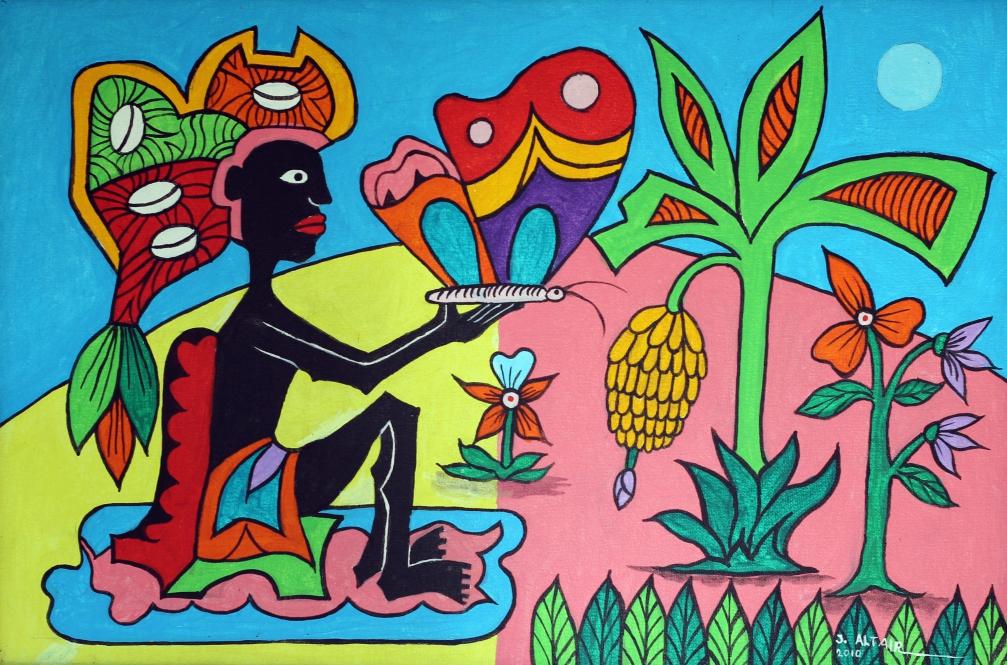

Lodo (no rio)
Acrílica s/ Eucatex, 2009 80 x 50cm
Coleção Particular
Muló (levar embora)
Acrílica s/ Tela, 2010 63 x 43cm
Coleção Particular
53
Coleção Ingênuo e Primitivo Naïve and Primitive Collection

Borí (dar de beber e comer a cabeça)
Acrílica s/ Tela, 2011 59 x 49cm
Abomalè (aquele que cultua os ancestrais)
Acrílica s/ Tela, 2010 43 x 63cm Coleção Particular

54
Coleção Ingênuo e Primitivo Naïve and Primitive Collection
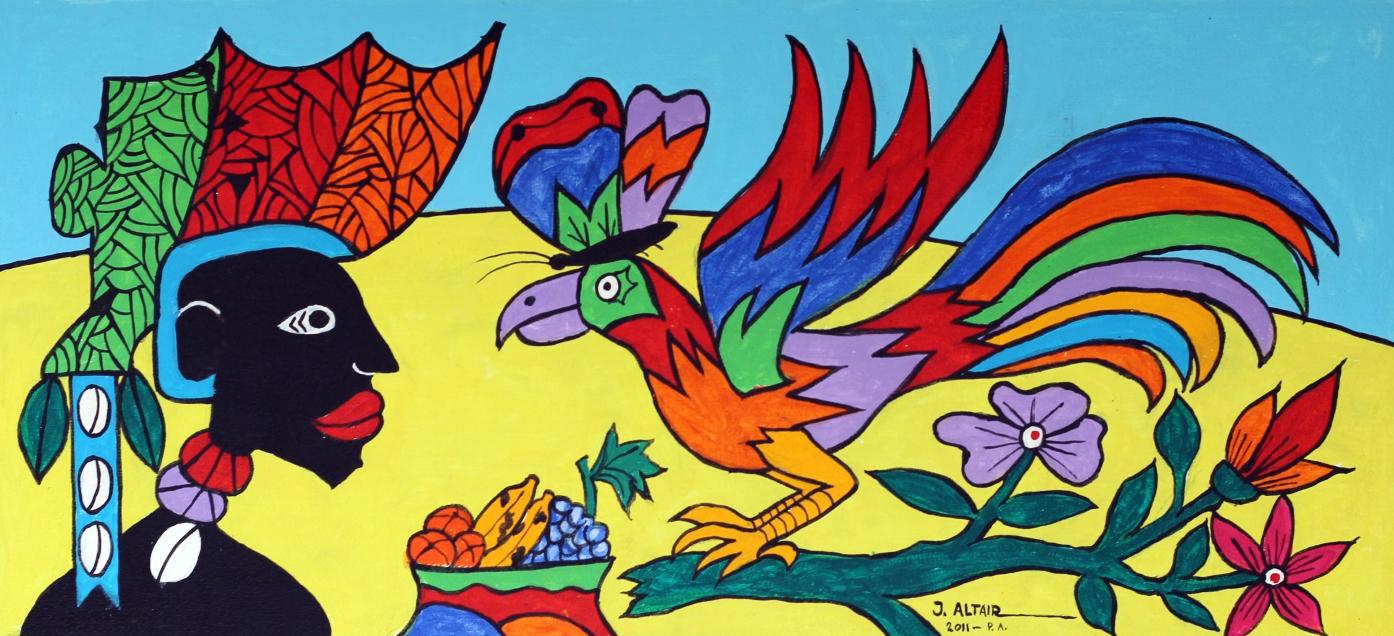
Abiã (aquele que vai nascer)
Acrílica s/ Tela, 2011 75 x 60cm
Ségègé (tirar a sorte)
Acrílica s/ Tela, 2011 75 x 60cm

55
Coleção Ingênuo e Primitivo Naïve and Primitive Collection

Òbukó (bode)
Acrílica s/ Tela, 2011 32 x 48cm

K'àgò (pedir permissão)
Prêmio Talentos da Maturidade Santander
Acrílica s/ Tela, 2011 62 x 52cm Coleção Particular
56
Coleção Ingênuo e Primitivo Naïve and Primitive Collection


Ìbà (homenagem em respeito aos orixás)
Acrílica s/ Tela, 2011 53 x 36,5cm
Ósan (fruta)
Acrílica s/ Tela, 2010 73 x 44,5cm
57
Coleção Ingênuo e Primitivo Naïve and
Primitive Collection
Làí - Làí (o começo)
Acrílica s/ Eucatex, 2011 43,5 x 81cm
Ìyá - àgan (mulher mais velha)
Acrílica s/ Tela, 2011 75 x 60cm


58
Coleção Ingênuo e Primitivo Naïve and Primitive Collection

Fúnlèfólorun (dar liberdade)

Acrílica s/ Tela, 2002 32 x 48cm
Coleção Particular
Éèdì (encanto)
Acrílica s/ Tela, 2011 52 x 41cm
Coleção Particular
59
Coleção Ingênuo e Primitivo Naïve and Primitive Collection
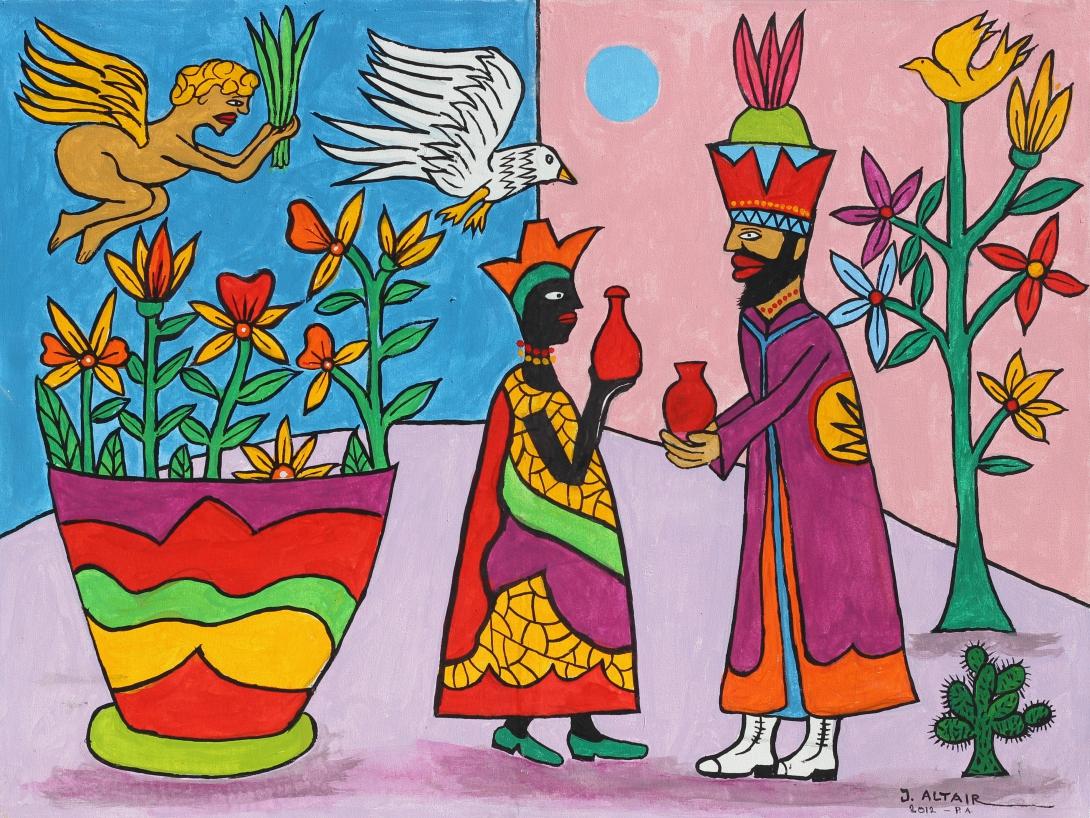

Eiyelé (pombo)
Acrílica s/ Tela, 2012 90 x 68,5cm
Fowólérán (agir com paciência)
Acrílica s/ Eucatex, 2012 63 x 49,5cm
60
Eiye (pássaro)
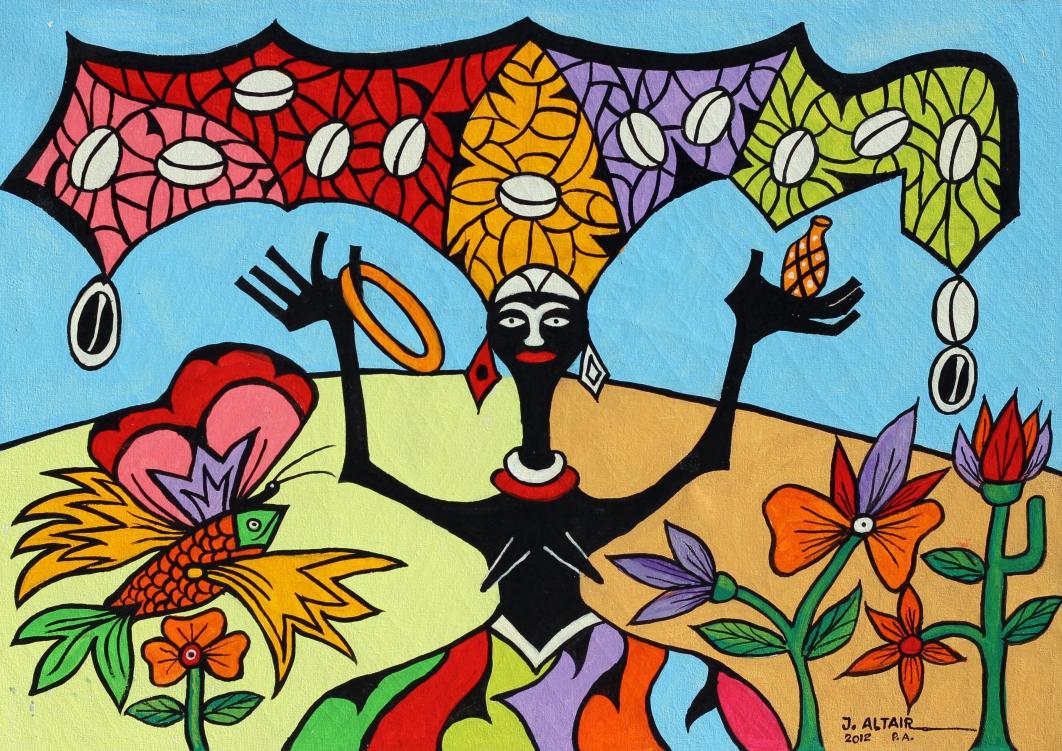

61
Coleção Ingênuo e Primitivo Naïve and Primitive Collection
Acrílica s/ Eucatex, 2012 83,5 x 53cm Acrílica s/ Eucatex, 2012 79 x 57cm Òsún (oxum divindade das águas)
Coleção Ingênuo e Primitivo Naïve and Primitive Collection

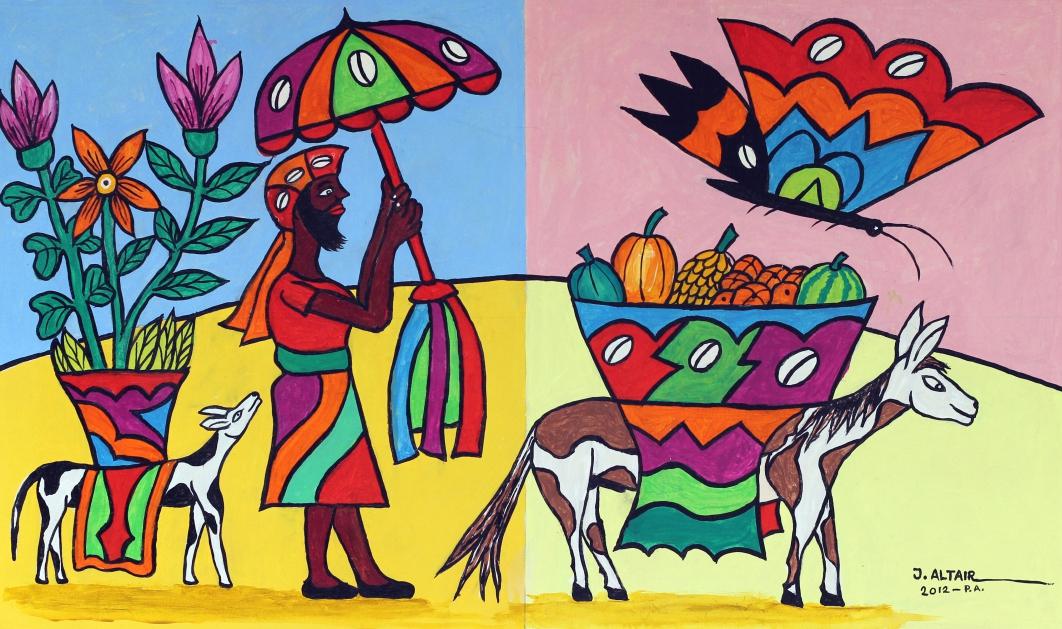
Adodo (justiça)
Acrílica s/ Tela, 2012 63 x 43cm
Délade (coroar um rei)
Acrílica s/ Eucatex, 2012 42 x 60cm
62
Coleção Ingênuo e Primitivo Naïve and Primitive Collection
Acrílica s/ Eucatex, 2012 53 x 44cm Agbadá (vestimenta sacerdotal)

63
Créditos
Credits
Esta é uma publicação da Black Brazil Art. Nenhuma parte deste catálogo pode ser reproduzida ou transmitida por qualquer forma ou processo eletrônico, mecânico ou fotográfico, sem autorização prévia e por escrito dos autores.
This is a publication os the Black Brazil Art. No part of this catalog can be reproduced or transmitted by any form, electronic, mechanical or photographic process, without previous writing permission of the authors.
Black Brazil Art www.blackbrazilart.com
Projeto Cultural e planejamento | Cultural design and planning Patrícia Brito
Projeto Gráfico | Catalog Designer Paulo Roberto Lopes de Souza – Gráfica Souza
Tradução | Translations Marcel Knecht
Impressão | Printed by Gráfica Souza
Tiragem | Number printed 1500 exemplares
Fotografias do catálogo | Photos of the catalog Isidoro B. Guggiana
Curadoria | Curatorial Staff Patrícia Brito
Textos da Exposição e Catálogo | Texts of the Exhibition and Catalogue Patrícia Brito Annette L. Willians
Revisão | Revision Daniela L. Oldenburg
Assessoria de Imprensa | Press Assistant Isidoro B. Guggiana Equipe CCCEV
Assistente de Produção | Production Assistant Karla A. I. Osório
Montagem | Assembly Project Equipe Cccev
Museografia | Museography Patrícia Brito
Iluminação | Exhibit Illumination Fernando Ochôa
Obras de Arte das Coleções | Art Works of the Collections Pinacoteca Aldo Locatelli – Prefeitura de Porto Alegre Museu Internacional de Arte Naif do Brasil
Foto da capa: A posição do joelho Acrílica s/ Eucatex, 2008 47,5 x 68cm
Foto da página 04: Sob o raio de Iansã e a espada de Ogum Acrílica s/ Eucatex, 1996 48,5 x 68,5cm Coleção particular
Produção Executiva | Executive Production Patrícia Brito
Apoio | Support COOHRREIOS RS
Financiamento | Financing Fumproarte
Parceiro cultural | Cultural partner Centro Cultural CEEE Erico Verissimo
Agradecimento Especial | Special Thanks Alex Sollus Ateliê Um Claudio Calmo
Jorge Foques Marilice Bastos Guimarães Marcel Knecht Oscar H. M. Cardoso
64
Ingênuo e Primitivo um tributo a J. Altair Naïve and Primitive a tribute to J. Altair

















































































